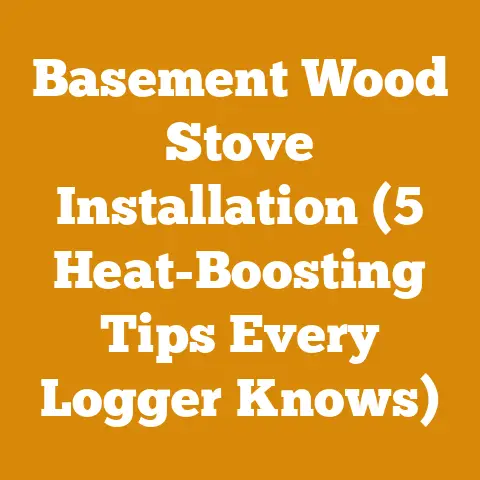Ceramic Spacers for Heat Shield (Woodstove Safety Tips)
I’ve seen my share of wood stoves age and show wear-and-tear.
Over time, the intense heat they generate can take a toll on the surrounding materials.
One crucial aspect of wood stove safety often overlooked is the proper use of heat shields and, more specifically, the role of ceramic spacers in maintaining their effectiveness.
Understanding the Importance of Heat Shields
Heat shields are essential safety components for any wood stove installation.
Their primary function is to reduce the clearance required between the stove and combustible materials like walls, furniture, and flooring.
By deflecting radiant heat, heat shields minimize the risk of fire hazards.
Without a properly installed heat shield, the surrounding materials can overheat and potentially ignite.
Building codes often mandate specific clearances, and heat shields are a common way to meet those requirements, especially in situations where space is limited.
How Heat Shields Work
Heat shields work by creating an air gap between the stove and the protected surface.
This air gap allows for convective cooling, where hot air rises and cooler air is drawn in from below.
This circulation helps dissipate heat and prevents it from building up on the combustible surface.
The effectiveness of a heat shield depends on several factors, including the size of the air gap, the material of the shield, and the overall design.
Properly installed heat shields can reduce surface temperatures significantly, making wood stoves safer and more efficient.
The Role of Spacers in Heat Shield Performance
Spacers are critical components in maintaining the air gap behind a heat shield.
They ensure a consistent distance between the shield and the wall, allowing for proper air circulation.
Without spacers, the heat shield might come into direct contact with the wall, negating its protective effect.
Ceramic spacers are a popular choice for wood stove heat shields due to their excellent heat resistance and durability.
They can withstand the high temperatures generated by wood stoves without deforming or degrading over time.
Why Ceramic Spacers?
Ceramic spacers offer several advantages over other materials like metal or plastic.
Their superior heat resistance, dimensional stability, and non-combustible nature make them an ideal choice for wood stove applications.
Heat Resistance
Ceramic materials can withstand extremely high temperatures without melting or losing their structural integrity.
This is crucial in wood stove installations where temperatures can fluctuate significantly.
I’ve seen metal spacers warp and deform under intense heat, compromising the effectiveness of the heat shield.
Plastic spacers, on the other hand, can melt or ignite, creating a fire hazard.
Ceramic spacers eliminate these risks, providing a reliable and long-lasting solution.
Dimensional Stability
Ceramic spacers maintain their shape and size even when exposed to high temperatures.
This ensures a consistent air gap behind the heat shield, which is essential for optimal performance.
Unlike some materials that expand or contract with temperature changes, ceramic spacers remain dimensionally stable, preventing the heat shield from shifting or coming into contact with the wall.
Non-Combustible
Ceramic materials are non-combustible, meaning they will not burn or contribute to a fire.
This is a critical safety feature in wood stove installations, where the risk of fire is always a concern.
I’ve always prioritized non-combustible materials in my wood stove setups, and ceramic spacers are a perfect fit.
They provide peace of mind knowing that they will not contribute to a fire hazard.
Durability
Ceramic spacers are incredibly durable and can withstand the rigors of wood stove use.
They are resistant to corrosion, wear, and tear, ensuring a long service life.
I’ve used ceramic spacers in several wood stove installations, and they have consistently outperformed other materials in terms of durability.
They remain in excellent condition even after years of use.
Selecting the Right Ceramic Spacers
Choosing the right ceramic spacers is crucial for ensuring the effectiveness and safety of your wood stove heat shield.
Consider the size, shape, and material of the spacers to ensure they meet your specific needs.
Size and Shape
The size of the ceramic spacers will determine the air gap between the heat shield and the wall.
Building codes often specify minimum clearance requirements, so it’s essential to choose spacers that meet those standards.
I’ve found that spacers with a diameter of 1 inch and a thickness of 1 inch provide a good balance between airflow and stability.
However, the ideal size may vary depending on the specific requirements of your wood stove and heat shield.
The shape of the spacers can also affect their performance.
Cylindrical spacers are a common choice, but other shapes like squares or discs can also be used.
Ensure that the spacers have a flat surface to provide stable support for the heat shield.
Material Composition
Ceramic spacers are typically made from materials like alumina, silica, or zirconia.
Each material has its own unique properties and advantages.
Alumina is known for its high strength and heat resistance, while silica offers excellent thermal stability.
Zirconia is a more expensive option but provides superior toughness and resistance to thermal shock.
I recommend choosing spacers made from high-quality alumina or zirconia for optimal performance and durability.
These materials can withstand the extreme temperatures and stresses associated with wood stove use.
Quantity and Placement
The number of ceramic spacers you need will depend on the size and design of your heat shield.
As a general rule, I recommend placing spacers every 12 to 18 inches along the perimeter of the heat shield.
Proper placement of the spacers is crucial for ensuring even support and airflow.
Avoid placing spacers too close together or too far apart, as this can compromise the effectiveness of the heat shield.
I typically use a grid pattern to distribute the spacers evenly across the heat shield.
This ensures that the shield is securely supported and that there is adequate airflow behind it.
Installing Ceramic Spacers
Installing ceramic spacers is a straightforward process that can be completed with basic tools and materials.
Follow these steps to ensure a safe and effective installation.
Preparing the Surface
Before installing the ceramic spacers, clean the wall and the back of the heat shield to remove any dirt, dust, or debris.
This will ensure a good bond between the spacers and the surfaces.
I typically use a wire brush and a mild detergent to clean the surfaces.
Rinse thoroughly with water and allow to dry completely before proceeding.
Attaching the Spacers
There are several ways to attach ceramic spacers to the heat shield and the wall.
One common method is to use high-temperature adhesive.
Apply a small amount of adhesive to the back of each spacer and press it firmly against the heat shield.
Allow the adhesive to cure according to the manufacturer’s instructions.
Once the adhesive has cured, position the heat shield against the wall and mark the locations of the spacers.
Apply adhesive to the back of the spacers and press them firmly against the wall.
I’ve found that using a level and a measuring tape can help ensure that the heat shield is properly aligned and that the spacers are evenly spaced.
Securing the Heat Shield
In addition to adhesive, you may also want to use screws or bolts to secure the heat shield to the wall.
This will provide extra stability and prevent the shield from shifting or falling.
Drill pilot holes through the heat shield and into the wall at the locations of the spacers.
Insert screws or bolts and tighten them securely.
I recommend using stainless steel screws or bolts, as they are resistant to corrosion and can withstand high temperatures.
Inspecting the Installation
After installing the ceramic spacers and securing the heat shield, inspect the installation to ensure that everything is properly aligned and securely attached.
Check that the air gap between the heat shield and the wall is consistent and that there are no gaps or obstructions.
Verify that the heat shield is level and plumb.
I always perform a thorough inspection after completing any wood stove installation to ensure that it meets all safety requirements.
Maintaining Your Heat Shield and Spacers
Proper maintenance is essential for ensuring the long-term effectiveness and safety of your wood stove heat shield and ceramic spacers.
Regular Cleaning
Clean the heat shield regularly to remove any dust, soot, or debris that may accumulate on its surface.
This will help maintain its reflective properties and prevent it from overheating.
I typically use a soft cloth and a mild detergent to clean the heat shield.
Avoid using abrasive cleaners or scouring pads, as these can scratch or damage the surface.
Inspecting for Damage
Inspect the ceramic spacers regularly for any signs of damage, such as cracks, chips, or deformation.
Replace any damaged spacers immediately to ensure the integrity of the heat shield.
I’ve found that a visual inspection is usually sufficient to identify any damaged spacers.
However, if you suspect that a spacer may be compromised, it’s best to replace it as a precaution.
Checking for Proper Airflow
Ensure that the air gap behind the heat shield is clear of any obstructions and that there is adequate airflow.
This will help dissipate heat and prevent the wall from overheating.
I typically use a flashlight to inspect the air gap and ensure that there are no obstructions.
If necessary, I may use a vacuum cleaner to remove any debris that may be blocking the airflow.
Common Mistakes to Avoid
When installing and maintaining wood stove heat shields and ceramic spacers, there are several common mistakes to avoid.
Using the Wrong Size Spacers
Using spacers that are too small or too large can compromise the effectiveness of the heat shield.
Ensure that you choose spacers that meet the specific clearance requirements of your wood stove and heat shield.
I’ve seen installations where the spacers were too small, resulting in inadequate airflow and overheating of the wall.
Conversely, using spacers that are too large can make the heat shield unstable and prone to shifting.
Improper Placement of Spacers
Placing spacers too close together or too far apart can also affect the performance of the heat shield.
Ensure that you distribute the spacers evenly across the shield to provide adequate support and airflow.
I recommend using a grid pattern to ensure that the spacers are evenly spaced.
This will help prevent hot spots and ensure that the heat shield is securely supported.
Neglecting Maintenance
Failing to clean and inspect the heat shield and spacers regularly can lead to reduced performance and increased risk of fire.
Make sure to establish a regular maintenance schedule to keep your wood stove installation safe and efficient.
I typically clean and inspect my heat shield and spacers at least once a year, or more often if I notice any signs of wear or damage.
Using Incompatible Materials
Using spacers made from incompatible materials, such as plastic or low-quality metal, can create a fire hazard.
Always use ceramic spacers that are specifically designed for wood stove applications.
I’ve seen installations where plastic spacers were used, which melted and created a fire hazard.
Always prioritize safety and use high-quality, non-combustible materials.
Case Studies and Real-World Examples
To illustrate the importance of ceramic spacers in wood stove safety, let’s examine a few case studies and real-world examples.
Case Study 1: Fire Prevention
In a rural community, a homeowner installed a wood stove without a proper heat shield.
Over time, the wall behind the stove began to overheat, eventually leading to a fire.
Fortunately, the fire was quickly extinguished, but it caused significant damage to the home.
After the incident, the homeowner installed a heat shield with ceramic spacers, which significantly reduced the temperature of the wall and prevented future fires.
This case study highlights the importance of using heat shields and ceramic spacers to prevent fires and protect your home.
Case Study 2: Improved Efficiency
In another case, a homeowner noticed that their wood stove was not heating their home efficiently.
After inspecting the installation, they discovered that the heat shield was not properly installed and that the spacers were missing.
The homeowner installed new ceramic spacers and properly secured the heat shield.
As a result, the stove heated the home more efficiently, and the homeowner saved money on heating costs.
This case study demonstrates the importance of proper installation and maintenance for maximizing the efficiency of your wood stove.
Real-World Example: Building Code Compliance
In many jurisdictions, building codes require specific clearances between wood stoves and combustible materials.
Heat shields with ceramic spacers are a common way to meet these requirements.
By installing a heat shield with ceramic spacers, homeowners can ensure that their wood stove installation complies with local building codes and regulations.
This example illustrates the importance of following building codes and using heat shields and ceramic spacers to ensure the safety and legality of your wood stove installation.
Advanced Heat Shield Designs and Considerations
Beyond the basic installation, there are advanced heat shield designs and considerations that can further enhance safety and efficiency.
Double-Wall Heat Shields
Double-wall heat shields offer superior heat protection compared to single-wall designs.
These shields consist of two layers of metal with an air gap in between, providing enhanced insulation and heat dissipation.
I’ve used double-wall heat shields in high-heat applications where maximum protection is required.
They are more expensive than single-wall shields but offer a significant improvement in performance.
Convection Heat Shields
Convection heat shields are designed to promote airflow and enhance convective cooling.
These shields often feature vents or louvers that allow for increased air circulation.
I recommend using convection heat shields in situations where there is limited space or where maximum heat dissipation is required.
Custom Heat Shield Designs
In some cases, a custom heat shield design may be necessary to accommodate unique wood stove installations or building configurations.
Custom heat shields can be fabricated from various materials, including metal, ceramic, and stone.
I’ve worked with homeowners to design custom heat shields that blend seamlessly with their home décor while providing optimal heat protection.
Heat Shield Materials
While metal is the most common material for heat shields, other materials like ceramic and stone can also be used.
Ceramic heat shields offer excellent heat resistance and durability, while stone heat shields provide a natural and aesthetically pleasing look.
I’ve seen stone heat shields used in upscale homes where aesthetics are a primary concern.
However, it’s important to ensure that the stone is non-combustible and properly installed.
Troubleshooting Common Issues
Even with proper installation and maintenance, you may encounter some common issues with your wood stove heat shield and ceramic spacers.
Spacers Coming Loose
If the ceramic spacers come loose, it can compromise the effectiveness of the heat shield.
This can be caused by improper installation, adhesive failure, or physical damage.
To fix this issue, clean the surfaces and reattach the spacers with high-temperature adhesive.
Ensure that the adhesive is fully cured before using the wood stove.
Heat Shield Warping
If the heat shield warps or deforms, it can reduce its effectiveness and create a fire hazard.
This can be caused by excessive heat, improper installation, or material failure.
To fix this issue, replace the heat shield with a new one made from high-quality materials.
Ensure that the new heat shield is properly installed and supported.
Insufficient Airflow
If there is insufficient airflow behind the heat shield, it can lead to overheating and reduced efficiency.
This can be caused by obstructions, improper installation, or inadequate ventilation.
To fix this issue, clear any obstructions and ensure that there is adequate ventilation behind the heat shield.
Consider using a convection heat shield to promote airflow.
Condensation
Condensation can form on the heat shield, especially in humid environments.
This can lead to corrosion and reduced effectiveness.
To prevent condensation, ensure that the wood stove is properly vented and that there is adequate ventilation in the room.
Consider using a dehumidifier to reduce humidity levels.
Safety Considerations
Safety should always be your top priority when working with wood stoves and heat shields.
Wear Protective Gear
Always wear appropriate protective gear, such as gloves, safety glasses, and a dust mask, when installing or maintaining your heat shield and ceramic spacers.
I’ve learned the hard way that safety gear is essential for preventing injuries.
Always take the time to protect yourself before starting any project.
Follow Building Codes
Ensure that your wood stove installation complies with all local building codes and regulations.
This will help prevent fires and ensure the safety of your home.
I always check with my local building department before starting any wood stove installation to ensure that I am in compliance with all applicable codes.
Use Non-Combustible Materials
Only use non-combustible materials, such as ceramic spacers, in your wood stove installation.
This will help prevent fires and ensure the safety of your home.
I’ve seen too many fires caused by the use of combustible materials in wood stove installations.
Always prioritize safety and use non-combustible materials.
Regular Inspections
Inspect your wood stove and heat shield regularly for any signs of wear or damage.
This will help identify potential problems early and prevent serious accidents.
I typically inspect my wood stove and heat shield at least once a year, or more often if I notice any signs of wear or damage.
The Future of Wood Stove Safety
As technology advances, the future of wood stove safety is likely to involve more sophisticated heat shield designs, improved materials, and advanced monitoring systems.
Smart Heat Shields
Smart heat shields could incorporate sensors that monitor temperature and airflow, providing real-time feedback and alerting homeowners to potential problems.
I envision a future where smart heat shields automatically adjust airflow to maintain optimal temperatures and prevent overheating.
Advanced Materials
New materials with improved heat resistance and durability could lead to more efficient and safer heat shields.
I’m excited about the potential of new ceramic materials that offer even greater heat resistance and dimensional stability.
Remote Monitoring
Remote monitoring systems could allow homeowners to monitor their wood stove and heat shield from anywhere, providing peace of mind and early warning of potential problems.
I believe that remote monitoring systems will become increasingly common in the future, allowing homeowners to stay informed and take proactive steps to prevent fires.
Conclusion
Ceramic spacers are essential components for ensuring the effectiveness and safety of wood stove heat shields.
By providing a consistent air gap, they allow for proper airflow and prevent combustible materials from overheating.
Choosing the right spacers, installing them properly, and maintaining them regularly are crucial steps for protecting your home and family from fire hazards.
Remember, safety should always be your top priority when working with wood stoves.
By following the guidelines outlined in this guide, you can ensure that your wood stove installation is safe, efficient, and compliant with all applicable building codes.
From selecting the right materials to performing regular maintenance, every step is important for protecting your home and family from the risks associated with wood stove use.
So, take the time to understand the importance of ceramic spacers and heat shields, and make sure your wood stove is installed and maintained properly.
Your safety depends on it.






